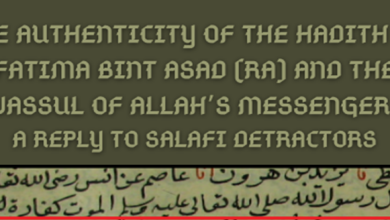A Diamond Among Rocks: Nisāb Al-Ihtisāb (The Manual of Al-Ihtisāb)
Among the many contributions of Islām which Muslims have rightfully boasted of through the ages has undoubtedly been its contribution in the line of academia. The very first revelation to the Messenger of Allāh (peace and blessings be upon him) bears first hand testimony to this fact. From the intricacies of language to the subtleties of the spiritual heart, Muslim scholars have left no stone unturned in their contribution to humanity in general, and to the Muslim community in particular. One subject, seldom discussed, yet has played an important role in the smooth regulation of the affairs of Muslims for centuries is al-Ihtisāb, or “enforcing public good and preventing public wrong.”
The topic of al-Ihtisāb has received much attention from scholars throughout the centuries. Some scholars have incorporated the subject of al-Ihtisāb into their more general works on Fiqh, such as Abu ‘l-Hasan ‘Alī al-Māwardī [d. 450 AH] in his al-Ahkām al-Sultāniyya, and al-Qādī Abū Ya‘lā [d. 458 AH] in a book with a similar title. Other scholars have authored independent treatises and works on the subject of al-Ihtisāb, such as Ahkām al-Sūq of Yahyā ibn ’Umar al-Andalūsī [d. 289 AH], which is one of the earlier works on the topic to have reached us, Nihāyat al-Rutbah fī Talab al-Hisbah of Jalāl al-Dīn al-Shīzarī [d. 589 AH], and Ma’ālim al-Qirbah fī Ahkām al-Hisbah of Muhammad ibn Muhammad al-Qurashī [d. 729 AH].
One work in particular that we wish to discuss in this brief article is Nisāb al-Ihtisāb of ‘Umar ibn Muhammad al-Sunnāmī [d. ca. 725 AH]. The manual is an indispensable masterpiece for every Hanafī scholar, in particular Hanafī Muftīs. One can gauge the value of the book by the countless material exclusively found therein. In addition, it is the first and perhaps the only available Hanafī manual written on the topic. Unfortunately, since the value of the book is often not realized, it is abandoned in a heap of unused books, thus making it a diamond among rocks.
We will first discuss the life of the author, followed by a description of the book. Thereafter, a translation of a few passages will be presented. A pdf file is attached for those interested in obtaining a digital copy.
The author
His name is ‘Umar, and his father’s name is Muhammad. He was given the title Diyā’ al-Dīn. He is known as al-Sunnāmī, ascribed to the city of Sunnām, which is situated in the province of Punjab, India. He was born and raised in India. Although his exact date of birth and death are unknown, from other indications we learn that he was born in the first half of the seventh century, and he passed away in the first quarter of the eighth century.
‘Umar al-Sunnāmī was born in an academically oriented family, as his father, Muhammad, was an expert scholar, and himself grew up to become one of the leading Hanafī scholars of his time. Among other sciences, he was very skilled in the Tafsīr of Qur’ān. One can gauge at al-Sunnāmī’s vast knowledge by reading his book Nisāb al-Ihtisāb, considering the variety of sources the author quotes therein: Fiqh, Hadīth, Tafsīr, Siyar, and Lughah etc.
Apart from his academic expertise, he possessed a high level of piety and a lofty rank in the eyes of the masses. He was very staunch against the people of innovation, and was not fearful of anyone in establishing the truth. He would hold a gathering of admonitions attended by an audience of three thousand.
In spite of his vast knowledge, ‘Umar al-Sunnāmī did not author many books. Perhaps this was due to the time constraints demanded by his occupation in the actual work of Ihtisāb. Some of his writings are the following: Nisāb al-Ihtisāb, Tafsīr of Surah Yūsuf, and al-Fatāwā al-Diyā’iyya.[1]
The book
To understand the book better, first we have to define its subject matter, i.e. al-Ihtisāb and al-Hisba. Lexically, al-Ihtisāb has two meanings. The first is “to take account,” and the second is “to reprimand.” Likewise, the word al-Hisba also has two meanings. The first is “to take account,” and the second is “to devise a plan.” From the perspective of Sharī‘a, it is defined as “To enjoin good when it is abandoned, and to prevent wrong when it is committed.” [2] Thus, we can understand that Nisāb al-Ihtisāb is a manual that discusses laws on how to regulate the affairs of the Muslims, by enjoining good and forbidding wrong.
Nisāb al-Ihtisāb is a compilation of juristic rulings specifically written on the topic of al-Ihtisāb. It comprises of sixty-four chapters, each chapter dealing with either the affairs of a particular class of people, e.g. al-Ihtisāb in relation to the poor, lecturers, travelers, or specific issues, e.g. al-Ihtisāb in relation to games, omens, and innovations in marriage ceremonies, among many other important topics.
The sources of the book are numerous and perhaps exceeds one hundred. Moreover, the author did not suffice on quoting from books of Fiqh but extended the scope of his book to include quotations from works on Hadīth Tafsīr, Siyar, and Lughah. One of its most beneficial features is the quotations taken from numerous rare books, such as al-Wāqi‘āt of al-Sadr al-Shahīd [d. 536 AH], al-Ajnās of Abu ‘l-Abbās al-Nātifī [d. 446 AH], and al-Īdāh of Abu ‘l-Fadl al-Kirmānī [d. 543 AH] [3].
In Nisāb al-Ihtisāb, the author compares the opinion of Imām Abū Hanīfah with his students. Occasionally, he points out the preferred view of the madhhab. Although he rarely delves into disputed issues, he occasionally discusses the views of Imām al-Shāfi‘ī and Imām Ahmad.[4]
Value of the book
Many factors make this work a masterpiece, some of which are:
- It is the only available Hanafī work on al-Ihtisāb
- The author was an expert in the field, as he assumed the post of al-Ihtisāb for a long period of time
- The author lived in the seventh century, thus he was relatively early
- The author gathered therein most of the issues found in other works where al-Ihtisāb is discussed
- It contains chapters found exclusively therein
- The author depends on reliable works of the madhhab
- He cites the reference for every issue he quotes from another work[5]
Passages from the book
The following is a translation of selected passages from Nisāb al-Ihtisāb:
Chapter Ten: Al-Ihtisāb in Eating, Drinking and Medication
If a person eats from the middle portion of a piece of bread, leaving out the sides, if he wastes the sides it will be reprehensible, and if he gives it to someone else, there is no reprehensibility, as this is similar to him taking a slice of bread for himself, instead of another slice.
To wipe the knife or fingers with a piece of bread will be reprehensible if the bread is wasted, and if he eats it then some scholars are of the opinion that it will still be reprehensible and according to others, there is no problem…[6]
Chapter Fourteen: Al-Ihtisāb Regarding the Person Who Informs the Muhtasib of Vice
When a person is committing sin, if a second person informs the Sultān of his condition to deter him, than there is no sin (i.e. in passing this information). It is mentioned in al-Khāniyya [i.e. Fatāwā Qādī Khān]: if he knows that the Sultān is capable of preventing the subordinates and populace from their vice, it is permissible to write to him. However, if he knows that the Sultān is incapable of doing so, he should avoid writing to him, to prevent unnecessary enmity and hatred.[7]
Chapter Sixty-Four: Al-Ihtisāb by Removing From the House
…Question: When a strange woman comes for consoling and begins to wail on the deceased, is it permissible for the Muhtasib to take her out of the house?
Answer: Yes, it is permissible, because ‘Umar removed the sister of Abū Bakr from his house when she began wailing over him. From Sahīh al-Bukhārī.[8]
Conclusion
In brief, Nisāb al-Ihtisāb is an indispensable manual for every Hanafī scholar as the author has collected scattered rulings onto one platform, thus saving the researcher the difficulty of reading through voluminous works. It was for this reason that Abū Sa‘īd al-Khādimī [d. 1176 AH] quotes from it excessively in his al-Barīqah al-Mahmūdiyyah, and Mawlānā ‘Abd al-Hayy al-Lakhnawī [d. 1304 AH] and Muftī ‘Abdur Rahīm Lājpūrī [d. 2003 CE] both in their respective Fatāwā collections.[9]
The book was printed in Makkah by Maktabah Tālib al-Jāmi‘ī and edited and annotated by Dr. Marīzan Sa‘īd Marīzan. Although currently quite difficult, it will be very beneficial to get hold of a hard copy.[10] In any case, we have attached a pdf file for those interested in using a digital copy in the meantime.
Click for the Pdf file of Nisab al Ihtisab (2)
And Allāh knows best,
Muntasir Zaman
———————————————————————————————-
[1] Al-Hasanī, Nuzhat al-Khawātir, 182:2 [Dār Ibn Hazm] Marīzan Sa‘īd, Prologue to Nisāb al-Ihtisāb,17 [Maktaba al-Tālib al-Jami‘ī] [2] Al-Sunnāmī, Nisāb al-Ihtisāb, 81 [3] Mufti Husain Kadodia, Introduction to the Hanafī Works [4] Al-Naqīb, al-Madhhab al-Hanafī, 631:2 [5] Mufti Husain Kadodia, Introduction to the Hanafī Works [6] Al-Sunnāmī, Nisāb al-Ihtisāb, 148 [7] Ibid., 162 [8] Ibid., 398 [9] Mufti Husain Kadodia, Introduction to the Hanafī Works [10] Ibid.




